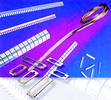Contact strips for shielding enclosures from EMI/RFI
14 February 2001
Circuit & System Protection

Bavaria Elektronik has available contact strips used to close and thereby shield gaps between two surfaces. For optimum shielding performance, the contact strip must be in a position to span the min and max gap. The right strip is selected if its height is 20% greater than the max gap and if it can be suppressed to the min gap.
The contact strips are made from beryllium copper which has good spring quality, material strength and flex survival. Further advantages are corrosion resistance and self-cleaning of contacts by opening and closing. Beryllium copper is not damaged by air, ozone, solvent, UV light or even by nuclear radiation. It is suitable for a wide temperature range and shows superior thermal and electric conductivity. In comparison to other EMI/RFI gaskets, the manufacturer says these contact strips are lighter and require less closing force.
Inflammable and free from outgassing, the wide assortment with different designs and the simple installation create a universal shielding gasket. It is simple to install as it comes in clip-on and double sided adhesive tape mounting versions.
The adhesive tape can be used up to 120°C and many clip-on strips can optionally be provided with lances to enhance fixing. Mounting holes allow screw or rivet support and soldering or spot welding can ensure superior transition. With all installation methods electrochemical reactions must be considered to avoid galvanic corrosion. Surface coatings are available to help to eliminate this.
Further reading:
Clearing the Static: Staying grounded
Actum
Circuit & System Protection
To maintain reliable electrostatic discharge control, regular testing and accurate measurement are essential, with grounding products and ESD testing equipment being vital.
Read more...
Smarter protection without disruption
NewElec Pretoria
Circuit & System Protection
Designed for operations still running without integrated automation, NewElec’s retrofit-friendly systems let you upgrade performance and safety without overhauling your entire network.
Read more...
Circuit breaker for reliable, compliant protection
RS South Africa
Circuit & System Protection
Legrand’s low-voltage power distribution portfolio encompasses the DX3 range of miniature circuit breakers, designed to deliver dependable protection in residential, commercial and industrial installations.
Read more...
Reducing noise on power supply lines
Future Electronics
Circuit & System Protection
Murata has introduced the EMIFIL ESD Series Noise Filters, a breakthrough solution engineered for superior noise suppression and enhanced electrostatic discharge (ESD) protection.
Read more...
Clearing the Static: Fundamental principles of static control
Actum
Circuit & System Protection
Controlling electrostatic discharge in electronics manufacturing is essential with effective ESD programs built on six key principles.
Read more...
Electrical fire safety in lithium-ion battery rooms
Circuit & System Protection
Pratliperl is a non-combustible, ultra-lightweight aggregate that can be mixed with cement and applied as a plaster or screed to walls, floors, and ceilings.
Read more...
Clearing the Static: ESD training in the workplace
Actum
Circuit & System Protection
To protect sensitive electronic components, A structured, consistent, and sustainable ESD training program is essential.
Read more...
Protect your pumps – protect your profit
NewElec Pretoria
Circuit & System Protection
In South Africa’s demanding agricultural landscape, irrigation is not just an essential service – it is the heartbeat of farm productivity.
Read more...
Clearing the Static: ESD and installation: A durable antistatic solution
Actum
Circuit & System Protection
ESD flooring provides a reliable, long-term solution for managing static electricity by safely dissipating static charges through the floor to a designated ground point.
Read more...
Why wait to automate
NewElec Pretoria
Circuit & System Protection
NewElec’s initiative helps you gain operational visibility via HMI or PLC by retrofitting intelligent motor protection relays without replacing MCCs or rewiring the plant.
Read more...


